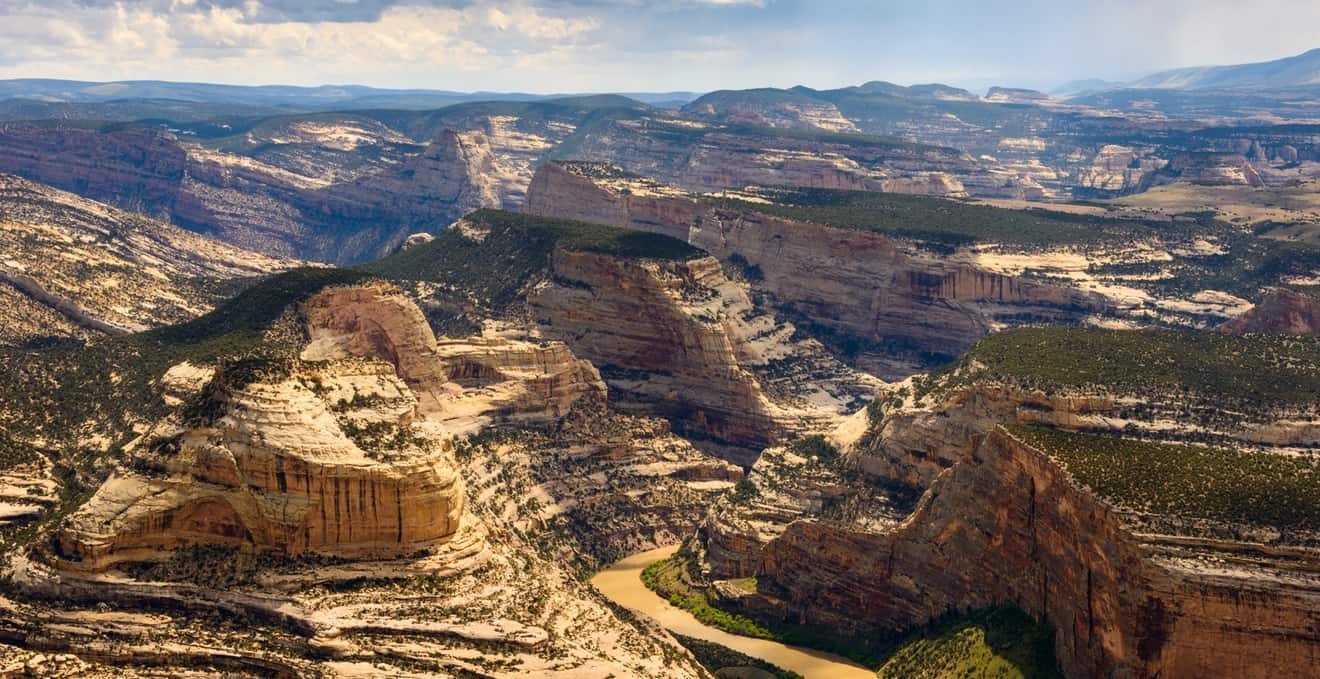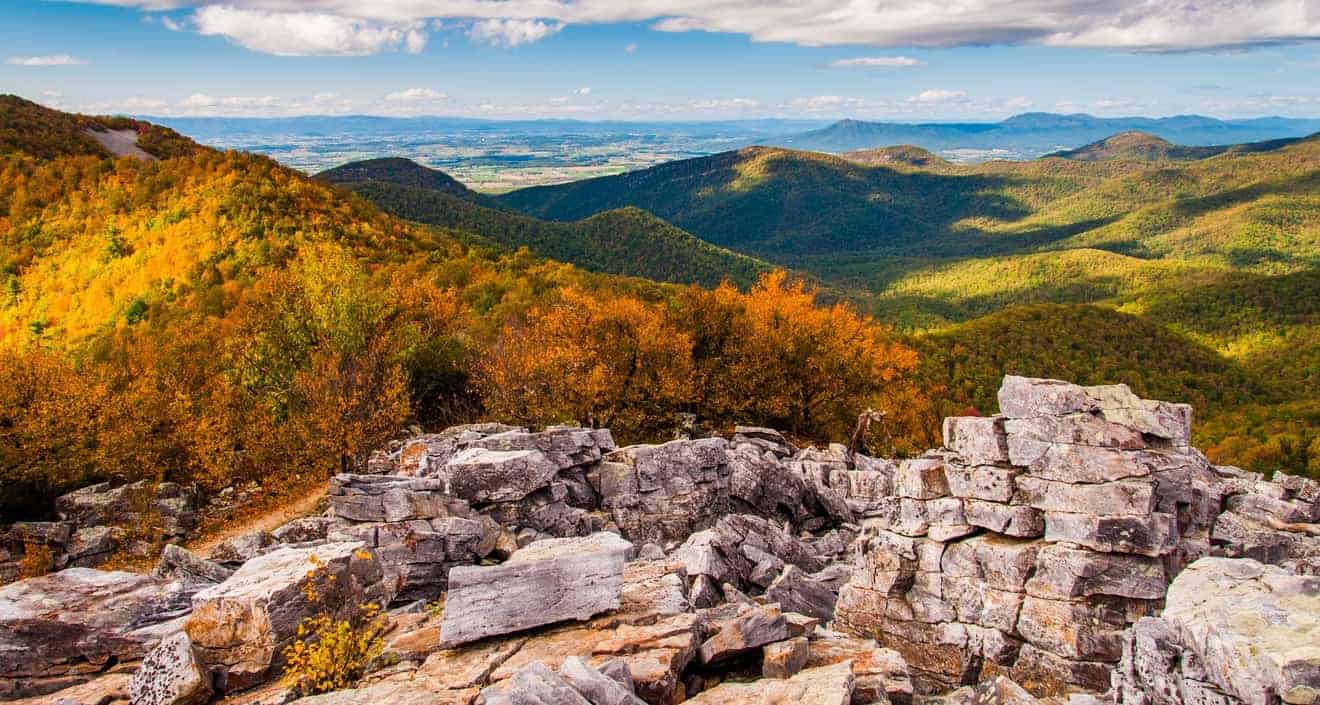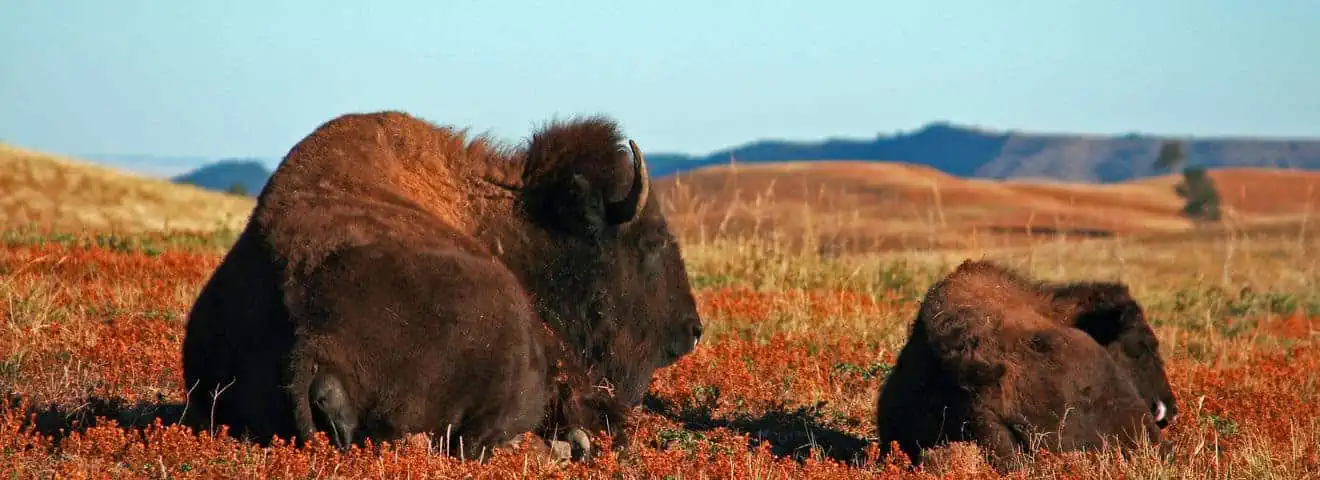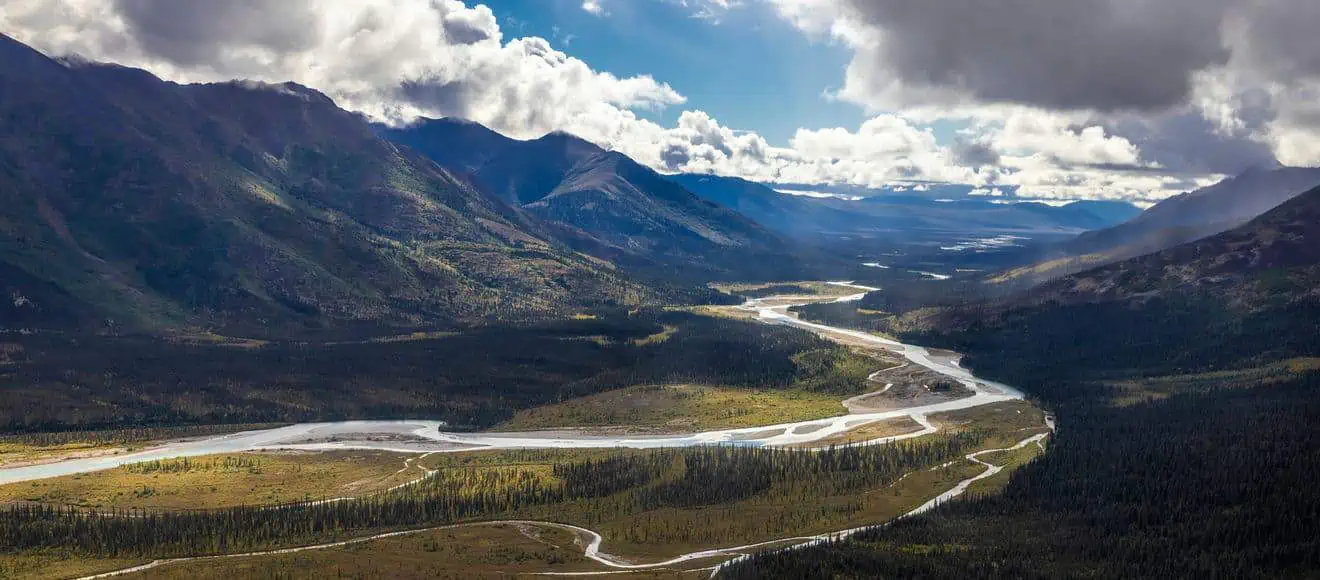Dinosaur National Monument is a very unique park and relatively unknown to travelers since it is far from the routes of classic Southwest itineraries. In fact, the park is located exactly on the border between Colorado and Utah, so you may consider visiting this area if you are planning an itinerary through Colorado and the other states in the Great American West or to Yellowstone.
This national monument is near Vernal, an important town for tourism in Northeastern Utah. Two very different natural wonders such as Flaming Gorge and Fantasy Canyon, which we have already discussed in the articles you can read by clicking the links. Dinosaur National Monument is a fascinating archaeological site where dinosaur fossils and petroglyphs are preserved in an impressive landscape surrounded by canyons carved by the Green River and the Yampa River.
Here are some tips for visiting the main areas of Dinosaur National Monument, and some suggestions to help you make the most of your visit.
Contents
How to Get to the Dinosaur National Monument
There are two ways to get to the park, and you will have to choose not only based on your route, but also on what you are interested in.
- Dinosaur National Monument Quarry Visitor Center: Located in Jensen, Utah, this is the only section of the park where you can see dinosaur fossils. To get there you will have to drive to Jensen (15 minutes east of Vernal if you are coming from Utah) and follow the signs to the park, leaving US-40 E to UT-149 at this point. After about 6 miles you will see the visitor center on your left.
- Canyon Visitor Center: Located in Dinosaur, a small town in Colorado. As you can tell from the large number of dinosaurs on the side of the road, this town embraces its kitschy-prehistoric character. The area accessed from this Visitor Center does not offer a chance to see dinosaur fossils, but you can take a nice scenic drive (it’s closed when it snows) that leads to the park’s most beautiful viewpoint (Harpers Corner). To get to the Canyon Visitor Center from Utah, you will have to go past Jensen and down US-40 for about 34 miles to the junction with Harpers Corner Road, where the Canyon Visitor Center is located. Please note: As you will see, the Canyon Visitor Center is closed during the colder months, usually from early October to late April.
Hours and Admission Fee
Admission to the park is included in the national parks annual pass. If for some reason you did not purchase the pass, the fee is $25 per car or $20 per motorcycle.
Quarry Visitor Center Hours
- Summer (late May to mid-September): 8:00 am to 6:00 pm. Exhibit Hall closes at 5:30 pm.
- Winter (early December-end of February): 10:00 am-4:00 pm.
In March, April, and mid-September through the end of November, the visitor center is open from 9:00 am to 5:00 pm. Closed: December 25, January 1, and Thanksgiving Day.
Canyon Visitor Center Hours
- Summer (mid-May-end of September): 9:00 am-5:00 pm
- Spring (throughout the month of May): Saturday and Sunday from 9:00 AM to 5:00 PM.
- Winter (early October-end of April): Closed.
Closed: December 25, January 1, Thanksgiving Day, January 16, February 20, October 10, and November 11.
The Quarry Visitor Center Area (Utah)
The main reason for visiting the Utah section of the Dinosaur National Monument is, as mentioned above, to see the dinosaur fossils preserved in the Dinosaur National Monument Quarry Exhibit Hall. However, there is more to discover here. There are a number of scenic drives along which you can find trails, observation points, and archaeological sites.
Quarry Exhibit Hall
And here’s the moment all dinosaur enthusiasts have been waiting for: how do you get to the infamous Dinosaur National Monument exhibit? It couldn’t be simpler. Follow the directions above, you will need to stop 0.2 miles before at the Visitor Center and then take a special shuttle. At certain times of the year, you can arrive directly at the exhibit in your own vehicle and park outside.
The Quarry Exhibit Hall is a large building hidden among the colorful rocks of the desert, where a collection of 1,500 dinosaur fossils dating back about 150 million years is displayed. Young and old will be able to see with their own eyes (and in some cases touch) the remains of a large number of dinosaur species found in the Morrison Formation: Allosaurus, Apatosaurus, Camarasaurus, Diplodocus, Stegosaurus, and many more. In addition to housing a 24-meter mural with dinosaur footprints of all kinds, the exhibit is filled with information panels that tell the story of the giants that inhabited the area in the late Jurassic period. Programs facilitated by the rangers designed especially for children are also available.


Fossil Discovery Trail
If it is not too hot and you feel like taking a walk, you can go on the Fossil Discovery Trail, which connects the Visitor Center with the Quarry Exhibit Hall. Along this 2-mile trail, you can familiarize yourself with the geology of the area, including rock formations and small fossils embedded in the stones of the Morrison Formation. One option might be to use the shuttle on the way there and then return on foot on the trail.
Tour of the Tilted Rocks
After fantasizing about dinosaurs for a while, it’s time to get back on the road. On the Utah side of Dinosaur National Monument, there is the so-called Tour of the Tilted Rocks, a beautiful scenic route on Cub Creek Road. The road, partially paved, is 10 miles long and goes from the Quarry Visitor Center to the Josie Morris Cabin, where there is also the trailhead for two easy hikes into two adjoining canyons: Hog Canyon and Box Canyon. Here a some recommended stops along the way:
- Swelter Shelter (petroglyphs): 1 mile past the Visitor Center, you will find a clearing on the side of the road. Leave your car and cross to the knoll on the other side of the road. At the top of a short climb up the rocks you will find some very fragile petroglyphs (rock inscriptions) by the natives of the Fremont tribe dating back 1,000 years.
- Desert Voices Trail: Shortly after the clearing where the petroglyphs were located, you will find another on the left. Stop at this spot and walk the Desert Voices Trail (1.2 miles round-trip) to see for yourself the colors and rock formations of the desert that you have been able to see only through your car window as you are driving.
- Sound of Silence Trail: By taking a short detour from the main road (at this point 1.7 miles from Swelter Shelter), you will reach the Split Mountain Campground, which is located by the river. You will see Split Mountain, divided in half by Green River, creating a wonderful canyon that you can visit by boat. The Sound of Silence Trail, a 3-mile moderate loop among colorful rocks, also starts from the pier. If you have already done the Desert Voices Trail you can opt to skip it.
- Chew Ranch Overlook: The tour on Cub Creek Road continues and, after the junction with the campground, will skirt the Green River. After 1.2 miles, you will find information panels at this point and a beautiful view over the verdant valley framed by mountains and canyons
- Turtle Rock: Drive to this point, where you can stop the car and look for the turtle-shaped Entrada Sandstone towering over the road.
- Cub Creek Petroglyphs: Shortly after Turtle Rock, the paved road ends. Continue toward Josie Cabin and turn left at this point. Along the last 2.7 miles, you will find other points of interest at roadside clearings, including a very short trail through the rocks that leads to some of the park’s most mysterious petroglyphs.
- Josie Morris Cabin: The Tour of the Tilted Rocks concludes at Josie Morris Cabin, a log cabin nestled in a forest. Josie Morris is quite famous in this area. She settled here in 1914, where she lived in solitude (after 5 marriages, though!) growing a vegetable garden and raising pigs without succumbing to the lure of modernity. The little wooden house we can still see was built in 1935; it was located near a spring that provided Josie with the water she needed. It is said that Josie Morris was linked to the famous bandit Butch Cassidy, but it is not known how much truth there was to it. All that is known is that Josie died slipping on the ice while tending her horses.
- Hog Canyon and Box Canyon: Two easy hikes to Hog Canyon and Box Canyon start from the Cabin parking lot. The latter is a shorter walk (just 0.5 miles) and is in the shade, which makes it perfect especially in the summer. You will find the entrance right at the parking lot. Hog Canyon, on the other hand, is located just beyond Josie’s property. The hike is 1.5 miles long, and the landscape is similar to the previous one.
Other Scenic Roads
On the Utah side, there are two other scenic roads that you may consider driving if you have a lot of time.
Island/Rainbow Park Road
Those with an off-road vehicle and an adventurous spirit can drive this scenic dirt road to the Island and Rainbow Park, which consists of two wide valleys on the Green River. At Rainbow Park, it is also possible to go whitewater rafting, but the remains of the historic Ruple Ranch are the main attraction. Along the 30-mile drive to this area of the park, you will see a large number of rock formations and see the McKee Springs Petroglyphs.
Jones Hole Scenic Backway
This well-known scenic road, which crosses deserts and mountain landscapes, has an advantage and a disadvantage. The advantage is that it is all paved, the disadvantage is that it is very out of the way from the main park areas in Utah, so much so that it requires in my opinion a totally dedicated day trip.
If you are short on time, I would advise against taking this scenic drive. If, on the other hand, you want to take it all the way to the large valley that is home to the Jones Hole National Fish Hatchery, I recommend following the GPS directions directly from Vernal and not from the Quarry Visitor Center. Keep in mind that it takes 2 hours round trip from Vernal to travel the whole thing, not counting stops. A canyon trail starts from the parking lot of the fishing preserve along Jones Hole Creek and heads towards the Green River. On the way, you will find a small waterfall and some petroglyphs.
Driving on the Harpers Corner Road (Colorado)
If you are not so interested in dinosaurs and would prefer to see some nice views of the canyons of the Dinosaur National Monument, then you must cross the Colorado border to access the park via the Canyon Visitor Center. This is the beginning of Harpers Corner Road, a 50-mile scenic road that opens only during certain times of the year (in winter you will find it closed due to snow).
It takes at least 2 hours round trip, but it may take even longer if you want to take your time and make a few stops. Compared to the Tour on the Utah side, what distinguishes this steep and winding road is that it climbs over high ground and reaches an elevation of 1587 ft. However, the road is paved and easy to drive and at the end, it offers a remarkable bonus: an elevated viewpoint (2500 ft) above the canyons carved by the park’s two rivers.
- Plug Hat Butte: If you want to take a walk to see a secondary canyon in the park from above, stop your car at Plug Hat Butte and follow the Bull Canyon Rim Trail, a quick loop trail just under 2 miles long: you will arrive on the North Rim and enjoy the vast views across the canyon. If you don’t have time, you can settle for the view from the parking lot by taking the very short path to the viewpoint. PLEASE NOTE: The road closes at Plug Hat Butte during the winter closure.
- Canyon Overlook: Continue for 15.5 miles, to the junction that leads to Canyon Overlook. Here there are some picnic tables and a somewhat exposed lookout point (be careful if you have children!) that offers a nice view over the canyons in the heart of the park. If you are in a hurry, however, I recommend heading straight to the final destination, Harpers Corner, which offers a much more exhilarating view.
- OPTIONAL: Echo Park Road. This is one of the most exhilarating adventures in the Colorado section of the Dinosaur National Monument. If you have an ATV, you could take a detour off Harpers Corner Road at this point and enter Echo Park Road, a dirt road, which is in good condition, that descends from the plateau into the heart of the park to the point where the Green River and Yampa River converge, giving shape to the beautiful Steamboat Rock, which you can admire from the riverbank at the Echo Park Campground. Just before the campground, stop here to get some fresh air in the narrow Whispering Cave. WARNING: If you want to drive on this road in a 4×4, plan for at least a couple of hours: it’s 26 miles round trip!
- OPTIONAL: Yampa Bench Road. At this point on Echo Park Road, there is the junction with Yampa Bench Road, a very long and remote dirt road (41 miles) that leads toward the east side of the park to the connection with US-40. There is no shortage of excitement for off-road enthusiasts, nor any shortage of viewpoints over the Yampa River, such as the Wagon Wheel Overlook. However, if that is not for you, avoid this stop.


- Harpers Corner Trail: 6 miles after the junction with Echo Park Road- and after passing three more overlooks on the road (Island Park Overlook, Iron Spring Bench Overlook, and Echo Park Overlook) – you will have arrived at your destination. Park and walk the 2.4 miles to the park’s most beautiful overlook, Harpers Corner. When you reach the end of the trail, you will find yourself at 2625 ft above sea level: in front of you, you will see the canyons and the meandering Green River and Yampa River.
Where to Stay near the Dinosaur National Monument
Of course, where you spend the night depends on the itinerary. However, as you may have guessed, the best location is Vernal, where you will find various accommodations. Even if you are coming from Colorado, I recommend that you stop there. On the other hand, if you would like to get closer to the Lodore Canyon area, look for a place in Craig.













